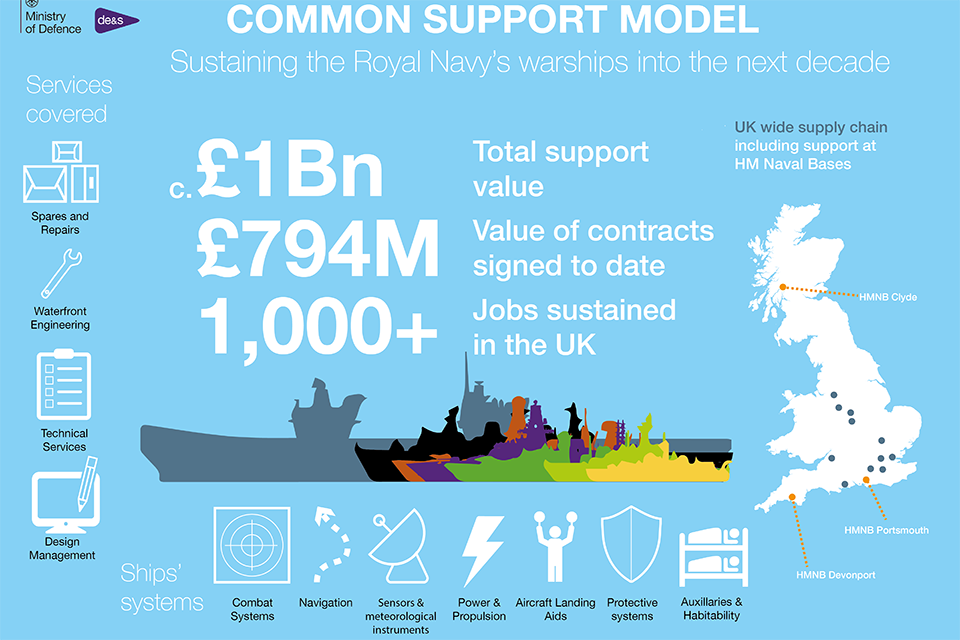News story: Defence Secretary to announce new £1bn support model for Royal Navy
The Common Support Model (CSM) will provide a framework for comprehensive support across the Royal Navy’s fleet of warships for decades to come in one new overarching arrangement.
The model will maintain the likes of both brand new Queen Elizabeth aircraft carriers, as well as all existing warships and will be able to incorporate future ships such as the Type 26 and Type 31e.
The new arrangement will bring together separate support agreements for individual ship types under a single, more efficient and more manageable model. Worth around £1 billion, it is set to improve the performance of service providers by having them adopt a common approach across all classes of complex warships.
The move aims to boost the performance and speed of all support, no matter what the ship, as well as making savings in equipment costs with the model providing a one-stop-shop for services required.
The model will establish a support system across the surface fleet, from the largest ships ever built for the Royal Navy, the nation’s new aircraft carriers, to the new Type 26 frigates being built on the Clyde and through to the likes of Minehunters and Royal Marine Amphibious Ships. It covers everything from combat management systems, fleet-wide communications and aircraft landing aids, through to spares, repairs and maintenance.
The suite of contracts will support over a thousand jobs in the UK, including at BAE Systems and Babcock in Portsmouth, Bristol, Devonport and on the Clyde, as well as Thales in Crawley and AGI Ltd in Poole.
The model will draw on the strong partnerships across UK Defence and world-leading skills to supply Royal Navy Engineering Technicians with the services and tools they need to keep the entire surface fleet effective at home and abroad, often far from home and in very challenging environments, and enhance the Royal Navy’s mission to protect the UK’s interests around the world.
10 of the 16 agreements, worth £794 million, included in the model have already been signed, with the others set to follow in the coming months.

Sir Simon Bollom, Chief of Materiel (Ships) for Defence Equipment and Support, the MOD’s procurement organisation, said:
Our surface fleet is made up of some the most advanced and capable fighting ships in the world. HMS Queen Elizabeth, the Royal Navy’s newest and most advanced Aircraft Carrier, will join the fleet soon and the Common Support Model will provide a framework that will deliver effective support to the Royal Navy’s warship fleet at home and around the globe.
The innovative, ambitious and far-reaching Common Support Model, which will drive efficiencies and greater availability, has been made possible by the enduring and strong relationships which exist between the Ministry of Defence, the Royal Navy, and our industry partners.
Notes to Editors:
The first ten contracts to be signed under the Common Support Model are:
-
Four contracts worth £320 million for Marine Systems Support Partner (MSSP) with Babcock, which will pay for spares, repairs and technical services for the Royal Navy’s Type 45 Destroyers and the new Queen Elizabeth Class Aircraft Carriers.
-
A £200 million contract for the Joint Support Solution 2 with BAE Systems to support combat management systems, tactical networks and shared infrastructures aboard 38 Royal Navy platforms including Type 23 Frigates, Type 45 Destroyers, QEC Carriers, Landing Platform/Dock (LPD) and Landing Platform Helicopter (LPH) ships and Mine Counter Measure Vessels, among others.
-
Two contracts worth £150 million for amendments to the Maritime Support Delivery Framework (MSDF) with BAE Systems and Babcock to ensure the continuing support of the Royal Navy’s entire surface Fleet, including the two new QEC Carriers.
-
A £100 million contract for internal and external communications systems support with Thales for fleet-wide communications support, including long-term support for the QEC Carriers and Type 45 Destroyers.
-
A £12 million contract with AGI Ltd to support Visual Landing Aids for aircraft on board ships including the QEC Carriers, Type 45 Destroyers, and the Royal Fleet Auxiliary’s Tide Class Tankers.
-
A £12 million contract for ships’ protective systems with Babcock for the current Royal Navy surface Fleet including QEC carriers, and submarines.








